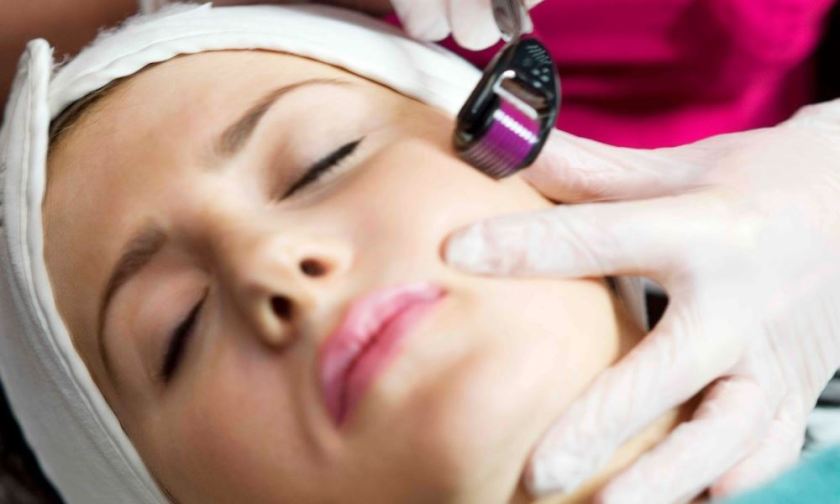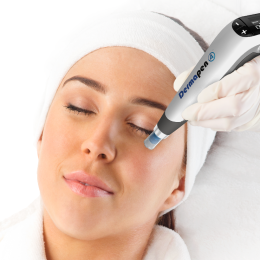Skin needling and facial acupuncture may share common goals of improved and lifted appearance, but the methodologies differ, as do the regulations about who can offer the services. Jenni Gilbert investigates.
Some of your clients will have heard about the results their friends and celebrities have had from facial needling and have decided to look at the pointy end. The first thing to find out is what they’re really asking about – skin needling or facial acupuncture. As a quick checklist, both involve needles to the face, both need to be offered in sanitary conditions and both offer potential lifting, firming, tightening and brightening effects. Additionally, both are designed to stimulate the skin’s collagen production, in different ways.
Skin needling goes by various names depending on the supplier of the training or equipment – you may hear it called micro-needling, dermal rolling, dermal stamping, percutaneous collagen induction (PCI) and collagen induction therapy (CIT) among them. There are two main types of devices – a manual roller (think a paint roller for the face but with tiny needles poking out) or, more commonly the case now, a mechanical ‘pen’ or ‘stamp’ that the needles thrust from and retract into at high speed.
The effects of skin needling will differ according to needle gauge and length and the manual pressure that’s used (when application is with a roller).
Facial acupuncture, aka facial rejuvenation acupuncture and cosmetic acupuncture is, as you’d expect, the use of Traditional Chinese Medicine acupuncture techniques to elicit a lifting and refreshing of the complexion – which will likely involve needles applied to the face and other areas of the body.
GET SMART
“Any form of facial acupuncture is limited to those qualified and insured to perform acupuncture,” explains Anthony Kingston, founder of White Lotus Anti Aging, one of the first specialist cosmetic acupuncture clinics in Australia.
While the regulations around who can provide acupuncture treatments is fairly comprehensive, “there is no national standard, law or ruling that states a therapist cannot draw blood,” says April Jorgensen, director of the Australasian Academy of Cosmetic Dermal Science, which offers nationally accredited graduate courses in dermal therapies encompassing skin needling theory and practical training. Hence, a therapist can essentially use any needling device their insurance policy allows them to use.
“However, in reality, a client is not going to endure the pain of a 3mm needling device without adequate anaesthesia – and usually adequate anaesthesia involves scheduled medications which the therapist cannot use,” she adds. According to Dr Gabrielle Caswell, president of the Cosmetic Physicians Society of Australasia and clinical director of Eyra Medical clinics in regional NSW, skin needling should be conducted or supervised by a doctor due to the risk of skin infections.
“Skin needling has a high risk of bacterial and viral infection and therefore this procedure should be conducted under medical supervision,” she says. “After care is also an issue for any invasive procedure.”
SAFETY FIRST
“The considerations are similar for all types of skin penetration,” says Anthony, who is also the author of Holistic Microneedling: The manual of natural skin needling.
“Single-use needling equipment should come in tamper- evident packaging to ensure sterility.” Adds April: “A qualified beauty therapist is capable of performing skin needling, though a dermal therapist with specific training in skin needling will have a greater depth of knowledge and skill. Specific training in infection control, preventing and treating needle stick injuries and identifying potential interactions and reactions to topical anaesthesia is essential.”
She points out that clinics must have sharps and swabs disposal containers available when performing either type of treatment.
TREATMENT IN ACTION
While the term ‘dermal rolling’ may sound all warm and fuzzy, depending on the needle length and gauge, skin needling will break the dermis, causing redness, some bleeding and pain. If as a therapist you’re not good with blood, the good news is that the deeper range of penetration (for dermal needling) may not be necessary for achieving collagen stimulation.
“The latest research shows that there is little difference between a 1mm and a 3mm needling device in terms of new collagen growth,” says Dr Lance Setterfield, author of The Concise Guide To Dermal Needling book and online course (needlingguide.com).
“In Traditional Chinese Medicine literature it would be said that facial acupuncture works by improving qi and blood flow and lifting the qi of the body to reduce sagging,” explains Anthony. “In modern terms, its affect is often attributed to collagen induction. This is a little limited in its understanding as in very authentic cosmetic acupuncture each line and wrinkle is associated with a specific organ in the body. By improving the functioning of this organ you can reduce the appearance of that specific sign of ageing.”
On the table, either treatment takes around the same time to deliver as other facials (both start with assessment and diagnosis of course). The needles are left in place for 20-30 minutes for facial acupuncture, while skin needling either with a machine or manual roller needs to cover the whole surface of the face. Deeper needling will require topical anaesthetic while the effects of shallow needling are supported by skincare application during and after. Some needling machines facilitate the application of serums at a controlled rate during needling so they are spread over the surface evenly.
Neither facial acupuncture nor dermal needling is a quick fix treatment.
Expert practitioners from both fields advocate a series of treatments and follow-ups. Most dermal needling proponents advise at-home rolling on a daily basis.
SO WHICH WORKS?
“It is easy to establish the validity of skin needling by performing a punch biopsy pre- and post-treatment to determine the new collagen growth as a quantitative figure,” says April of AACDS.
“However, the quantity and quality of new collagen laid down varies considerably between individuals.”She says that the results from facial acupuncture can be more subjective: “Because it is designed to relax muscles causing dynamic lines, it’s more difficult to determine validity.”
Both techniques work to some extent on the body’s own ability to produce collagen, according to Anthony. “But where a skin needling procedure will leave 250 punctures per square centimetre of skin, cosmetic acupuncture may use less than 25 needles on the whole face. “If it is only collagen induction you are seeking, skin needling is far superior and can produce a whole new layer of collagen across the entire face.
“However cosmetic acupuncture is often better to target very specific signs of ageing such as particular wrinkles and also to improve the constitution to prevent future signs of ageing.” Anthony sums up that facial acupuncture and skin needling can be combined. “We use them together with excellent results as they can complement each other very well.”
So, get stuck in! 
The Medical Board of Australia sets the professional standards that all registered medical practitioners must meet. A code of conduct for doctors in Australia is published on the board’s website (medicalboard. gov.au). The Australian Health Practitioner Regulation Agency (ahpra. gov.au) regulates acupuncture professionals through the Chinese Medicine Board of Australia (chinesemedicineboard.gov.au). Skincare professionals intending to offer needling services should seek coverage advice from their insurance company as well as undergoing specialty training.




